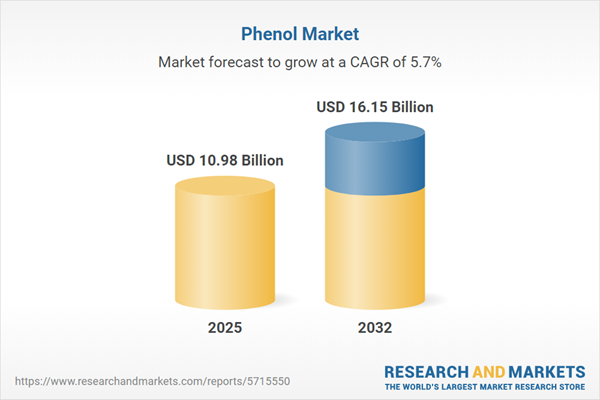Speak directly to the analyst to clarify any post sales queries you may have.
The phenol market is undergoing rapid change as technology, regulatory landscapes, and global supply networks reshape industry priorities for senior leaders. By staying agile and validating operations against new benchmarks, decision-makers can ensure long-term competitiveness and operational resilience.
Market Snapshot: Phenol Market Growth Outlook
The phenol market stands at USD 10.38 billion in 2024 and is projected to expand, reaching USD 10.98 billion in 2025 and USD 16.15 billion by 2032. This growth equates to a steady CAGR of 5.67%. Ongoing demand is sustained through a combination of specialty intermediates, adhesives, coatings, and advanced materials. Meanwhile, rapid developments in global regulatory frameworks and emerging resin technologies are prompting organizations to regularly evaluate their sourcing and production strategies. For those navigating the evolving phenol landscape, maintaining both strategic flexibility and operational insight has become imperative for effective market positioning.
Scope & Segmentation of the Phenol Market
This report is designed to arm senior leaders with clear, actionable intelligence, highlighting market-defining influences and strategic priorities across all major segments:
- Application Areas: Industrial adhesives, specialty lubricants, chemical intermediates, dyes, and high-performance resins drive advancement across coatings and engineered materials, keeping the market at the forefront of technological development.
- End Use Industries: Automotive, construction, electronics, pharmaceuticals, and polymer sectors depend on phenol for process consistency and product quality across regions.
- Grade Specifications: Electronic-grade, industrial-grade, and laboratory-grade phenol support both manufacturing volume and research needs while underpinning compliance and quality benchmarks.
- Production Processes: The cumene process and alternative synthesis strategies improve efficiency and cost management. There is an increasing focus on advanced production technologies to reduce risk and support future market needs.
- Distribution Channels: Direct sales, regional distributors, OEM partnerships, and digital procurement networks strengthen market penetration and ensure reliable supply for business continuity.
- Regional Coverage: North America, Latin America, Western and Eastern Europe, Middle East & Africa, and Asia-Pacific each present unique regulatory and demand-driven challenges, requiring region-specific strategies.
- Leading Companies: Key players profiled include INEOS Group Limited, China Petroleum & Chemical Corporation, Sumitomo Chemical Co., Saudi Basic Industries Corporation, Dow Inc., BP plc, Royal Dutch Shell plc, LG Chem Ltd., Chevron Phillips Chemical Company LP, and Evonik Industries AG, highlighting their innovation strategies and impact on global supply chains.
Key Takeaways: Strategic Insights for Senior Leaders
- Automation and data analytics are improving supply chain responsiveness while helping organizations navigate regulatory changes with greater speed and precision.
- Shifting toward renewable and bio-based feedstocks offers environmental gains and supports new regulatory requirements, helping build greater stakeholder trust.
- Procurement teams are deepening supplier engagement and deploying risk management strategies to maintain secure supply chains despite ongoing logistical challenges.
- Research and development investment is driving material innovation, making phenol applications more suitable for emerging technical demands in automotive and construction.
- Mergers and acquisitions are facilitating access to new technologies and creating opportunities for market expansion, supporting broader strategic goals.
Tariff Impact: Navigating Policy Shifts
Anticipated tariffs on US-origin phenolic feedstocks and derivatives set for 2025 are causing organizations to reevaluate procurement strategies. Companies are placing greater emphasis on domestic suppliers and renegotiating contracts to manage volatility and maintain resilience. As distribution networks shift to accommodate regulatory updates, close supplier collaboration becomes essential for securing business continuity and ensuring compliance.
Methodology & Data Sources
Findings in this report are based on in-depth executive interviews, supplemented by trusted secondary research sources. Frameworks such as Porter’s Five Forces, SWOT analysis, and value chain mapping ground the recommendations and provide structured support for strategy development.
Why This Report Matters
- Empowers leaders to align phenol supply chain strategy with the latest market and regulatory trends, enhancing both procurement effectiveness and operational compliance.
- Offers targeted advice for adopting new technologies and maintaining regulatory alignment, enabling executives to boost productivity and adapt to shifting industry standards.
- Delivers forward-looking guidance on risks and opportunities to support sustainable, data-driven business planning in a complex global environment.
Conclusion
Strategic adaptability and ongoing innovation are vital for sustained success in the phenol market. With informed leadership and proactive planning, organizations can address emerging risks while unlocking new potential for growth.
Additional Product Information:
- Purchase of this report includes 1 year online access with quarterly updates.
- This report can be updated on request. Please contact our Customer Experience team using the Ask a Question widget on our website.
Table of Contents
3. Executive Summary
4. Market Overview
7. Cumulative Impact of Artificial Intelligence 2025
Companies Mentioned
The companies profiled in this Phenol market report include:- INEOS Group Limited
- China Petroleum & Chemical Corporation
- Sumitomo Chemical Co., Ltd.
- Saudi Basic Industries Corporation
- Dow Inc.
- BP plc
- Royal Dutch Shell plc
- LG Chem Ltd.
- Chevron Phillips Chemical Company LP
- Evonik Industries AG
Table Information
| Report Attribute | Details |
|---|---|
| No. of Pages | 187 |
| Published | October 2025 |
| Forecast Period | 2025 - 2032 |
| Estimated Market Value ( USD | $ 10.98 Billion |
| Forecasted Market Value ( USD | $ 16.15 Billion |
| Compound Annual Growth Rate | 5.6% |
| Regions Covered | Global |
| No. of Companies Mentioned | 11 |









